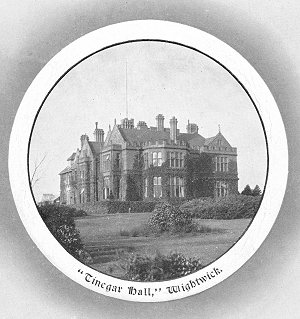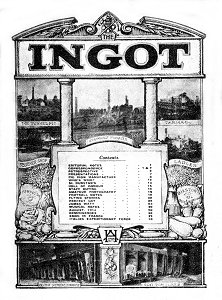|
|
|
|
In 1903 Alfred Hickman, by
now rolling in money, was created a baronet, and lived in some state
at Tinacre Hall on the outskirts of Wolverhampton, far from the dirt
and dust his works were creating in Bilston. He also became an MP for Wolverhampton. But his firm was not without concern for its workers. In 1910 they built a canteen for the workers and they also had a full-time welfare officer. In 1919 they started a works magazine called “The Ingot”. Alfred Hickman also gave Hickman Park to the public of Bilston and half the land for East Park in Wolverhampton. The East Park land was fully worked out and derelict, of no use to Sir Alfred and of no value; but the Hickman Park donation was a more munificent gift. |
The next part of this history of the works is taken from a duplicated document entitled “Brief History of the Bilston Iron and Steel Works”. A copy was kindly provided by Kath Kiely of Bilston. Its origins are unknown but it seems to have been written by someone well acquainted with the works and having technical knowledge. It was written well after nationalisation and there is no sign in it of any possible closure of the works. I have added paragraphing and made a few minor changes to the wording and punctuation of the text. If anyone knows anything of the origins of this documents, would they please contact me.
"At the end of the nineteenth century, a decision was taken to install gas engines, both to provide electricity and to blow the blast furnaces. These were supplied by the Premier Gas Engine Company of Sandiacre, Derbyshire, and the first two cylinder positive‑scavenge engine ever built was installed. It was a 1,000 h.p. engine and, apart from a small single cylinder built for experimental and works lighting purposes at Sandiacre, can be regarded as the pioneer of the principle of supercharging. The gas engine house, demolished in 1958 to make room for the modern charging arrangements of the Melting Shop, provided all electric power and lighting, with a total installed gas engine capacity of over 20,000 h.p.
"Immediately prior to the First World War, an extensive refrigeration plant was installed to remove the moisture from the blast of the furnaces, as it was well known that blast furnaces drove better in frosty weather. Much trouble was experienced with the compressor sleeve valves and the experiment was a failure, although the plant was kept in limited use as a store for the Hickman family’s game and their wives’ fur coats!
"In 1907 a new 36‑inch Cogging Mill was installed, driven by a Ward‑Leonard Ilgner set supplied by the Electric Construction Company of Wolverhampton. This was another first for a mill of that size, and probably of any size, in the United Kingdom. (Two other Ward‑Leonard Ilgner sets were being installed at the same time in Middlesborough by other makers on smaller mills and there can only have been a matter of weeks between the starting dates.) This equipment was to remain in service until the late 1950s and performed yeoman service during the Second World War, rolling 22 ton ingots of armour piercing steel for the production of 25‑pounder shells.
| "The change‑over to Open Hearth Steelmaking
finally come about during the First World War and the nucleus of
the shop was completed in 1919. The “A” Furnace of 40‑ton capacity
was equipped with electric tilting gear. Subsequently, this furnace
was rebuilt to provide a 55‑ton capacity, hydraulically tilted and
fitted with a Radex basic roof, which was spring compressed and
fitted with special follow‑up gear to maintain the shape of the arch
during cooling and heating. This roof achieved a world record output
and, immediately suitable British materials were available again
after the war, the record was broken on three further occasions. "All subsequent furnaces were of a nominal 80/100‑ton capacity, a very suitable size for the wide variety of ingot sizes required for tube manufacture by various processes. Incidentally, all the steel for “Pluto” (Pipe Line Under The Ocean) was made at Bilston during World War II. |
|
"Stewarts and Lloyds Limited acquired the works in 1921 to provide a source of steel for tube making."



